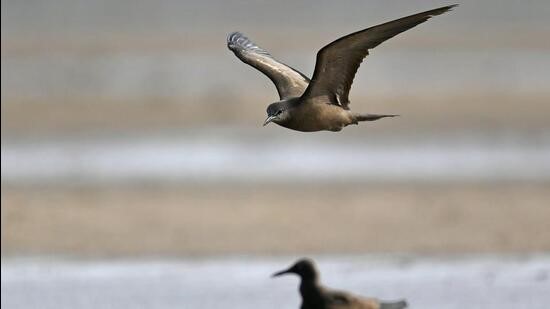Description

Disclaimer: Copyright infringement not intended.
Context
- In Gujarat, recently birdwatchers have reported sighting Pelagic birds, including species like shearwaters, petrels, storm petrels in inland areas.
- It is unusual as these are mainly seen in coastal and offshore regions.
Other Details
- These are oceanic avian species started venturing into inland areas after Cyclone Biparjoy is passed.
- They were seen in Bhavnagar, Nalsarovar, Jamnagar
- Their presence in inland areas is believed to be a result of cyclone’s powerful winds and turbulent weather conditions.
- They were seen in Morbi, Jamnagar, Dwarka, and other coastal regions of Gujarat.
- Bird watchers gather in Nal Sarovar, a ramsar site, to see Sooty tern and other sea birds
Reason for their sighting in Inland areas
- Due to recent cyclone, food from the depths of the ocean has been brought up to upper layers of ocean, attracting the birds to forage in its vicinity.
- Due to powerful cyclonic winds their course could have redirected towards the land, making it challenging for them to remain in the open sea.

Pelagic birds
- These are the birds which are adapted to forage in the open ocean which can be found thousands of miles offshore both in tropical and polar areas.
- However most of such birds are generally found up to 50 nautical miles of the coast.
- They majority of their lifespan in open seas far from the coast.
- They also come to inland for breeding purpose.
Other Features
- They have an ability to utilize oceanic currents and winds to conserve energy for their flight.
- Some of the examples are brown noddy, Persian shearwater, sooty tern, shearwaters, petrels, storm petrels, bridled tern, arctic skua etc.
- As per a study conducted by Swansea University and other institutes Pelagic seabirds in the Sea of Japan were seen deliberately flying towards the eye of the storm to avoid being forced onto land.
- By doing this these birds avoids pushing towards land and reduce the risk of injury or death.
- Their diet includes fish, crustaceans, planktons, mollusks
- Dense and waterproof feathers - diving species have shorter wings.
- Generally webbed feet which help then in catching fishes, swimming with ease.
- Layers of fat to keep them warm.
- They filter salty sea water before drinking using filter in their bills
Habitat and distribution
- Found mainly in coastal waters.
- Many of these species are observed to nest on isolated islands and cliffs of northern Europe, Russia and the American continent.
- Generally found in offshore areas of Gujarat, these are not sighted commonly.
Conservation Status
- These seabirds are the most threatened bird group
- Globally 28 per cent are threatened.
- 5 per cent are in the highest category of Critically Endangered
- Further 10 per cent are Near Threatened.
Threat
At sea
- Incidental bycatch.
- Pollution like oil spills, marine debris.
- Overfishing which impacts their food security.
- Energy production and mining.
On land
- Invasive alien species.
- Abundance of problematic native species.
- Human disturbance.
- Infrastructural, commercial and residential development.
Significance
- They provide many ecosystems services.
- They are potential indicators of marine health
- Also an indicator of food availability in oceans.
- Contribute towards biodiversity of Planet.
|
PRACTICE QUESTION
Consider the following statements about Pelagic birds:
1. This birds generally sighted near inland areas.
2. These birds, in general, are considered least vulnerable as per IUCN.
Which of the statements given above is/are correct?
A. 1 only
B. 2 only
C. Both 1 and 2
D. Neither 1 nor 2
Answer: (D)
|

https://www.hindustantimes.com/cities/others/birders-catch-rare-glimpse-of-seabirds-in-onshore-regions-of-gujarat-101687698679772.html












